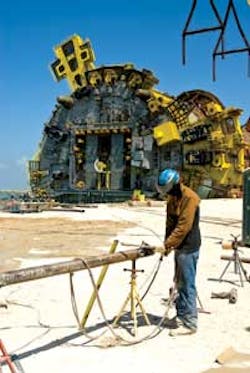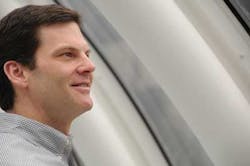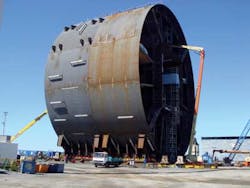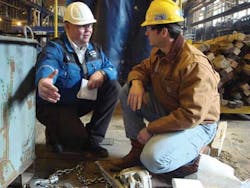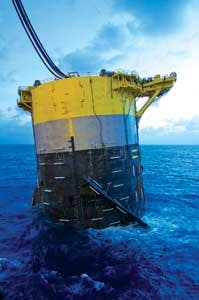Building the world’s deepest drilling and production platform
Shell has more than 30 years of success in the design, fabrication, installation and operation of the world’s most advanced deepwater systems. Perdido is Shell’s first spar host drilling and production platform – a system selected because of the extreme water depths, the nature of the reservoirs and remoteness of the field.
Technip was announced as the spar and mooring contractor in April 2006 and began working on a detailed design in June. An engineering, procurement and construction (EPC) contract was awarded to Technip USA in November 2006 for the design, fabrication and dry transport of the spar and mooring system for the Perdido development.
For efficiency in building the overall team, the spar and mooring leads for Shell shared office space with Technip’s project management, with integrated teams working at both companies’ offices in Houston, Texas. The spar fabrication site team was based at Technip’s fabrication yard in Pori, Finland. Senior managers from both companies attended an alignment workshop in October 2006, and subsequent team-building sessions in Finland and Houston helped establish an excellent working relationship from the start.
Heerema Marine Contractors (HMC) was named in the spring of 2006 as the primary transportation and installation contractor. It was a critical step, because the finished spar and topsides would have to be designed to fit the capacities of the available transport and installation vessels. To complete Perdido, Shell needed two of the largest installation vessels in the world: Hereema’s Balder for the spar and Thialf for lifting and setting the single-lift topsides. Hereema’s project team, based in Leiden, The Netherlands, worked directly with Shell’s transportation and installation team in Houston.
Perdido was Technip’s 14th spar project. When fabrication began, the same Technip yard was completing another spar for one of Shell’s partners on Perdido.
“We chose a design similar to what Technip had built before,” Lohr says. “We made modifications, of course, but part of my job was to balance which of those changes added value to the project and which of them were just preferences. It was also very helpful to see another spar taking shape in the yard.”
Off to a good start
Senior managers went to Finland one month before the contract was awarded, again to make sure that everyone was aligned on safely delivering the project goals. Shell employed a larger site team than Technip had traditionally worked with, including a significant team of inspectors and safety coaches. The continual presence of the safety coaches at Technip’s yard helped ensure that the priority on safety was maintained while delivering on the challenging construction schedule. This proactive approach included safety events and demonstrations to reinforce that safety was the top priority and that “goal zero – one shift at a time” was achievable.
The Shell site team at Technip grew to 14 members. Although that’s small by Shell standards, it was the largest client team that Technip had ever seen.
“The key was convincing Technip that we were not on site to police the work,” Lohr recalls. “We were there as partners working toward common goals. We brought the best Shell had to offer in terms of our construction and deepwater experience, and I think that the team, working together in Finland and in Houston, delivered a superior product.”
The Spar
Perdido’s spar includes a cylindrical upper section (the hard tank), a trussed midsection of tubular legs and braces, and an enclosed octagonal bottom section (soft tank) to contain the fixed ballast. The outer diameter of the hard tank is 118 feet (36 meters), which is small enough to allow offshore installation of the topsides by the Thialf, yet large enough to provide the required buoyancy and to contain the platform’s various liquid storage tanks.
The spar is 555 feet (169 meters) tall, with a draft of 505 feet (154 meters) and gross weight of 20,000 tons (18,143 tonnes). Strakes around the circumference of the hard tank are standard equipment on deepwater spars. Strakes help keep the platform from oscillating by disrupting the flow of ocean currents around the spar.
Hands-on management in Finland
Paul Dixon, senior staff engineer, oversaw construction of the Perdido spar in Finland.
“There were about 1,700 people at the yard every day and I met as many of them as I could,” he says. “I wanted to talk to people and make sure they knew me. I wasn’t critical of their work, I just wanted them to know that I did not want to meet their families for the wrong reasons.”
One of the biggest challenges in building the spar was a delay in the project ahead of Perdido. The oil market was booming, so every shipyard was busy. A huge new power plant was also under construction just 60 miles south of the Technip yard, so skilled workers were hard to find.
Welders cut the first piece of steel on November 1, 2006, right on schedule, but in January Technip managers told Shell that they needed to take some of the engineers and fabrication people off the project for a while so they could finish the other spar in the yard. The loss of the engineering staff was especially bad news, because their work has to be done before procurement and fabrication. Any delays were critical, since offshore transport and installation vessels are scheduled more than a year in advance.
“Even though fabrication started on time, the manpower needed was reduced,” Dixon says. “Technip employed a local engineering company that it had worked with before and knew the process. Technip also brought a crew of 40 fabricators from Poland to the yard.”
The extra engineering staff and the fabrication crew helped make up for lost time in the yard, but it was difficult to keep up. To avoid any safety issues caused by a difference in language, the Polish crew worked on specific areas of the spar in a separate portion of Technip’s yard but used the same HSE management plan.
“That actually worked to our advantage,” Dixon says. “The Polish workers were good, so we’d tell the Technip guys, ‘Look how clean their area is.’ Later, we’d go to the Polish workers and say, ‘Look how well the Finnish workers are doing.’ Everyone knew we were teasing, but it helped to set up some friendly competition.”
Safety in the fast lane
Of all the Shell-sponsored safety promotions at the Technip yard, one stood out. It was the day that the popular Finnish race car driver, Kimi Räikkönen, came to visit.
“First thoughts of the event were in October 2006 and we worked until August of 2007 to make this happen,” Dixon says. “At the time of Kimi’s visit, he was three wins away from winning the 2007 world championship in Formula 1.”
Räikkönen, who was driving that season for Ferrari and sponsored by Shell, is a national hero in Finland. Dixon knew he would draw a big crowd.
Dixon wanted something special, so he met with Räikkönen before the event and spoke about it not being about Technip or Shell or Ferrari that day. “On that day, I wanted him to talk to the people of Finland about safety. They love him. They respect him. I knew they would listen.”
Dixon asked the racer to talk about his job, how he prepares for a race, his personal safety gear and the safety features of his car. “I asked him to show the people how much he focuses on safety. I wanted the people to see that it’s the same thing we do here.”
That inspirational message, coming from such a respected figure, captured everyone’s attention. About 1,200 attended the event, and most went home thinking not just about safety on the job, but also safety in their personal lives and the lives of those around them.
“If there was a special achievement in that event, that was it, Dixon says. “I think we had a lot of fun and changed a lot of lives that day.”
A continuing jobsite presence
Shell’s 14-member spar fabrication team let people know they were interested in the work. At least once a week, two site team members would visit on one of the three shifts. Their primary role was to show Shell’s presence in the Technip yard. Observations were written down after each tour.
“That was when those of us on the site team really got to know each other well,” Dixon says. “The third shift was the hardest. It was from 11:00 p.m. to 7:00 a.m. These were different hours than the site team would typically work and we would go in pairs to watch out for one another. We didn’t want to ignore the night shift and all the hard work being performed.”
In April 2007, large individual segments of the spar were being assembled, and it started to look like a spar. By then, workers had logged some half-million safe hours on the job. One worker was injured, resulting in the first recordable. The contractor was not sure what Shell’s initial response to the recordable incident would be, but Dixon decided it was time to celebrate the project’s good safety results to date. T-shirts were printed and Shell provided meals for all three shifts. Site team members greeted workers and thanked them for the 500,000 safe hours so far, and encouraged them to try for 1 million.
Between management, engineering and fabrication, the total workforce reached about 1,700 people at more than a dozen sites throughout Finland. Site team members visited them all. One major fabricator was 8 hours away from the site team’s base in Pori.
Managers from the various subcontractors also visited the Technip yard.
“We had a Contractor Day early on,” Dixon says. “We took them all around the Technip yard to show them what we were doing, how we were doing it and why. Then we listened to what the subcontractors were doing well and why. It was the first time that had been done, and I believe that it contributed to the project’s outstanding safety record. The Perdido development has logged more than 10 million man hours without a lost-time incident. About a quarter of it came from the spar fabrication site, and I’m very proud of that.”
Sail-away
Fabrication at the Technip yard continued from November 2006 until May 2008. After more than 2.3 million man hours of work without a lost-time incident, the spar was skidded aboard the semi-submersible Dockwise Shipping’s Mighty Servant 1 in Pori, Finland on May 27 for the 8,200-mile (13,200-kilometer) dry transport to Kiewit Offshore Services in Ingleside, Texas.
“That was an emotional day,” Dixon says. “Watching the spar sail away was like watching your child go off to college.”
The spar arrived at Kiewit’s yard on June 19, 2008, for final outfitting. Kiewit also built the Perdido topsides at the Ingleside fabrication yard. The spar spent a month and a half at the Ingleside yard in preparation for offshore installation. The spar sailed from the yard on August 8 for the final 150-mile wet tow to its final location in the Perdido field.
The mooring system
All of Shell’s previous deepwater mooring systems have used steel mooring lines; Perdido is the first to use mooring lines that are primarily polyester. “We’ve used polyester rope before on drilling and storage structures, but this is Shell’s first application for a permanent deepwater drilling and production system,” Lohr says. “The 9-inch polyester lines are much lighter than steel, so our decision to use them greatly reduced the payload requirements of the floating structure.”
Perdido’s mooring system consists of nine anchor lines that average more than two miles in length. The nine taut lines are oriented in a 3x3 pattern, and are anchored to the seabed by 18-foot diameter suction piles that range from 87 to 103 feet in length.
Hereema’s SSCV Balder entered the Perdido field on June 20, 2008, to install the first cluster of suction piles. Each pile was individually upended, lifted overboard and lowered to the seafloor, where it was oriented correctly before being allowed to penetrate the seabed under its own weight a few feet into the mud. A remotely-operated underwater vehicle (ROV) was used to close the water relief valves at the top of the pile, then to apply suction until the pile reached its target penetration. The water depth of the mooring piles ranged from about 7,600 to 8,600 feet. The installation of pile P6 at 8,631 feet set a new world record for the deepest permanent mooring pile.
Since polyester rope is more difficult to handle in a winch, the ends of each mooring line are fitted with lengths of chain. On the seabed, ground chains and mooring shackles connect the polyester mooring lines to the suction piles. At the surface, dedicated chain jacks on the platform control tension on the lines. Perdido employs an “active” mooring system, which means that the mooring lines can be pulled in or let out to reposition the spar over drilling locations on the seabed, reaching any point within an area roughly 350 feet in diameter.
INSTALLING THE SPAR
From Ingleside to the field took two days, and from the moment the spar arrived on August 10, 2008, the activity was nonstop.
Ulbricht, who joined the project in late 2004 during the concept development phase, was initially responsible for the topsides fabrication, offshore installation, offshore hookup and offshore coordination, but as the project progressed toward the offshore phases, the OCT became his primary focus.
One of the Offshore Coordination Team’s key responsibilities was to manage all of the tugs, barges, supply boats, umbilical vessels, the dive vessel, support vessels, anchor handlers, seismic vessels, and the heavy-lift and drilling vessels working in the field. The goal was to coordinate all the offshore activities, from dockside sailaway to first production, and to manage and resolve any vessel conflicts that might impact the offshore schedule.
With the water ballast hoses from the Balder connected to the spar, a sequence of tanks were filled to continue the uprighting of the spar. Some 3.5 days after operations began, the spar was upright in the water ready for the mooring lines to be connected.
“The team was a huge success,” Ulbricht says. “During the two years of offshore operations, we had between 90 and 100 different vessels that were in the field at one time or another. Throughout the installation of the spar and topsides, there were no marine vessel safety incidents, and we had very little standby time for any of the vessels waiting for another vessel to complete its work.”
